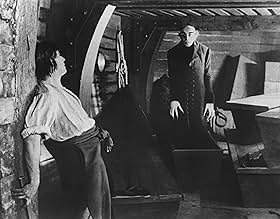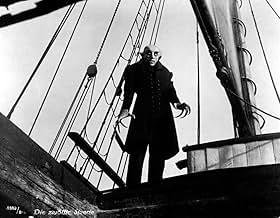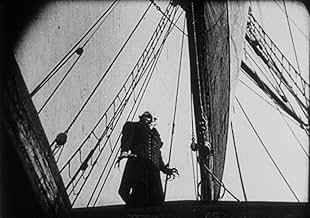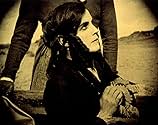Hutter, envoyé par son patron dans les Carpates, doit proposer une nouvelle résidence au comte Orlok. Le vampire, séduit par la photo de l'épouse de son invité, s'embarque pour Wisborg, sema... Tout lireHutter, envoyé par son patron dans les Carpates, doit proposer une nouvelle résidence au comte Orlok. Le vampire, séduit par la photo de l'épouse de son invité, s'embarque pour Wisborg, semant la peste sur son passage.Hutter, envoyé par son patron dans les Carpates, doit proposer une nouvelle résidence au comte Orlok. Le vampire, séduit par la photo de l'épouse de son invité, s'embarque pour Wisborg, semant la peste sur son passage.
- Réalisation
- Scénario
- Casting principal
- Récompenses
- 3 victoires et 2 nominations au total
Gustav von Wangenheim
- Hutter
- (as Gustav v. Wangenheim)
Greta Schröder
- Ellen - seine Frau
- (as Greta Schroeder)
Georg H. Schnell
- Harding - ein Reeder
- (as G.H. Schnell)
Karl Etlinger
- Kontrolleur am Kai
- (non crédité)
Hans Lanser-Ludolff
- A magistrate
- (non crédité)
Loni Nest
- Child at Window
- (non crédité)
Fritz Rasp
- Knocks Mitarbeiter
- (non crédité)
Josef Sareny
- Head Coachman
- (non crédité)
Fanny Schreck
- Krankenschwester im Hospital
- (non crédité)
Eric van Viele
- Matrose 2
- (non crédité)
Avis à la une
F.W. Murnau's version of the 'Dracula' legend still remains as distinctive and memorable as ever. The enjoyable Bela Lugosi version is perhaps easier to watch, and strictly as light entertainment it might work better, and many later versions brought their own interpretations - but nothing matches "Nosferatu" for its engrossingly morbid atmosphere and its unusual interpretation of the main character.
Max Schreck and Murnau were able to create an image of the vampire that remains in your mind long after seeing it. Regardless of whether it or some other conception is closest to the 'true' Dracula (if such a thing even exists), it is quite effective, and it was particularly well-conceived for a silent screen version that cannot rely on dialogue to define a character. The settings and the story perfectly complement Schreck's weird character, creating an atmosphere full of constant strangeness, uncertainty, and foreboding.
It's unnecessary (and probably impossible) to make detailed comparisons among all the film versions of the Dracula character and legend. "Nosferatu" stands perfectly well on its own, as a unique and skillfully done adaptation of the story, and as one of the memorable classics of the silent era.
Max Schreck and Murnau were able to create an image of the vampire that remains in your mind long after seeing it. Regardless of whether it or some other conception is closest to the 'true' Dracula (if such a thing even exists), it is quite effective, and it was particularly well-conceived for a silent screen version that cannot rely on dialogue to define a character. The settings and the story perfectly complement Schreck's weird character, creating an atmosphere full of constant strangeness, uncertainty, and foreboding.
It's unnecessary (and probably impossible) to make detailed comparisons among all the film versions of the Dracula character and legend. "Nosferatu" stands perfectly well on its own, as a unique and skillfully done adaptation of the story, and as one of the memorable classics of the silent era.
Quite possibly my own very favourite movie. No vampire film before or since has been either as disturbing or as artful. Less overtly "expressionistic" than some of the other German films of the day, but no less visually impressive. Look at the seascape where Ellen/Nina/Mina pines over her departed husband. Watch those marvelous shadows, which we see in Bremen more often than the vampire itself, used especially effectively in the closing sequence.
And look at Max Schreck himself! While Bram Stoker gave his Count affinity with wolves and bats, Murnau favours that rat, both in that they surround him and that he physically resembles a shaved, cadaverous rat. Spreading his pestilence, Max Schreck is truly the vilest, most loathsome villain in the history of film. The scene where he rises suddenly erect from his coffin aboard ship is one that horror directors everywhere should study very carefully.
Nosferatu is also noteworthy as the origin of the idea that vampires are killed by sunlight, previously present neither in literature nor folklore. In response to the poster who complained that the vampire seems to be walking around in light before his death, these scenes are set at night. In the original versions, there was a blue tint over these scenes to let you tell night from day; it's difficult to tell the difference without them.
My copy is marred with some hilarious inappropriate sound effects (such as a massive "BOING" when the gates of the castle open on their own accord) which I've learned not to hold against the film itself.
Thank God that Florence Stoker did not manage to completely wipe this film of the face of existence.
And look at Max Schreck himself! While Bram Stoker gave his Count affinity with wolves and bats, Murnau favours that rat, both in that they surround him and that he physically resembles a shaved, cadaverous rat. Spreading his pestilence, Max Schreck is truly the vilest, most loathsome villain in the history of film. The scene where he rises suddenly erect from his coffin aboard ship is one that horror directors everywhere should study very carefully.
Nosferatu is also noteworthy as the origin of the idea that vampires are killed by sunlight, previously present neither in literature nor folklore. In response to the poster who complained that the vampire seems to be walking around in light before his death, these scenes are set at night. In the original versions, there was a blue tint over these scenes to let you tell night from day; it's difficult to tell the difference without them.
My copy is marred with some hilarious inappropriate sound effects (such as a massive "BOING" when the gates of the castle open on their own accord) which I've learned not to hold against the film itself.
Thank God that Florence Stoker did not manage to completely wipe this film of the face of existence.
Nosferatu is a great horror movie (possibly the first ever according to some accounts), and one of the pinnacles of the German silent era of film-making. Made in the silent age by the German expressionist/auteur FW Murnau, the film has the genuine power to act creepy, odd, alluring, mythic, and beautiful by way of images and music that don't leave your mind once the film is over. It's like someone collected a stash of nightmares and pulled them together with the original Bram Stoker story of Dracula. Max Shreck, in his most notorious role (and apparently the only one really anyone's bothered to see) plays the monstrous Count Orlock, a vampire who comes out at night to tempt the living and, of course, to suck blood. Though this story of Dracula has been numerously repeated (even by the Hollywood version in the early 30s), this film is one of the prime examples of how horror SHOULD be done- dispense with cheap thrills or overloading with exposition.
A director like Murnau here, who had total artistic control (abeit the film not in circulation for many years), could transform Orlock's world into one of acute, deliberate angles, long deep shadows, and painting with light like some mad artist from the dark ages. One could almost claim that this, alongside Night of the Living Dead, changed the way audiences looked at horror films, that a style and presence could be wrung from characters that bring out the worst fears and dread in common people. Years from now, long into the digital age, there may still be room for of all things a silent, non-talking effort like Nosferatu, where the terror can still be felt through the black and white (sometimes tinted) photography and stark physical performances by Schrek and the others. In short, a film like this is one of the reasons I love to watch horror movies.
A director like Murnau here, who had total artistic control (abeit the film not in circulation for many years), could transform Orlock's world into one of acute, deliberate angles, long deep shadows, and painting with light like some mad artist from the dark ages. One could almost claim that this, alongside Night of the Living Dead, changed the way audiences looked at horror films, that a style and presence could be wrung from characters that bring out the worst fears and dread in common people. Years from now, long into the digital age, there may still be room for of all things a silent, non-talking effort like Nosferatu, where the terror can still be felt through the black and white (sometimes tinted) photography and stark physical performances by Schrek and the others. In short, a film like this is one of the reasons I love to watch horror movies.
For copyright reasons, Bram Stoker's novel was filmed with the names of the characters changed (Orlok for Dracula, for example) but otherwise the story remains the same: a young man goes on a trip to see a mysterious count in order to sell a house, leaving his bride behind, and finds that the creature he meets is not of this world.
As the extremely creepy Orlok, Max Schreck is brilliant, with his long fingernails and gaunt appearance. A triumph in early cinematic make-up. Gustav von Wangenheim portrays the confusion of the victim well, as does Greta Schroder as his wife. FW Murnau directed the film with flair, showing us not only shadowed vistas and abandoned castles, but the nature outside (foxes) and miniature worlds evolving under a microscope. This film sits well with his later 'Sunrise' in showing the effect of outside forces on a young couple, as well as being one of the key early horrors in its portrayal of Stoker's anti-hero.
This version of the Dracula tale remains one of the best, although all have some different perspective on the novel. On the strength of 'Nosferatu' alone, Murnau deserves his place as a true innovator of silent cinema.
As the extremely creepy Orlok, Max Schreck is brilliant, with his long fingernails and gaunt appearance. A triumph in early cinematic make-up. Gustav von Wangenheim portrays the confusion of the victim well, as does Greta Schroder as his wife. FW Murnau directed the film with flair, showing us not only shadowed vistas and abandoned castles, but the nature outside (foxes) and miniature worlds evolving under a microscope. This film sits well with his later 'Sunrise' in showing the effect of outside forces on a young couple, as well as being one of the key early horrors in its portrayal of Stoker's anti-hero.
This version of the Dracula tale remains one of the best, although all have some different perspective on the novel. On the strength of 'Nosferatu' alone, Murnau deserves his place as a true innovator of silent cinema.
10jhclues
In 1921, director F.W. Murnau set out to make a horror film based on Bram Stoker's novel, `Dracula,' but was denied the rights to the property by Stoker's estate. Undeterred, however, Murnau merely changed the title to `Nosferatu,' the name of the title character to `Count Orlok,' then proceeded to make what has come to be considered nothing less than a classic of the silent film era. An unsettling film (especially for the times in which it was made), it is a faithful adaptation of Stoker's story, and brings images to the screen, the likes of which at the time, had never before been seen. And although by today's standards much of it may seem relatively tame, there is an innate sense of the sinister about it that is timeless. For the same elements that so unnerved audiences in 1922 when it was released, are equally discomfiting now, most of which is courtesy of Max Schreck, who portrayed Count Orlok. It was the first screen appearance for what is now the most famous vampire in history, and the German character actor Schreck brought an eerie presence to the role that has never been equaled. Bela Lugosi may be considered the definitive Dracula-- his portrayal is certainly the most well known-- but even he could not match the sense of evil that Schreck brought to the character. The scene in which Schreck's shadow is cast on the wall as he slowly negotiates a staircase, emphasizing his misshapen head and elongated fingers and nails, is an image that leaves an indelible impression on the memory, as does Schreck's overall appearance: Lanky, though slightly stooped, with oversized, pointed ears and haunted, sunken eyes. It was Schreck's greatest screen role, and had it not been for a lawsuit by Stoker's estate that prevented wide distribution of the film, it would no doubt have made him a star. The supporting cast includes John gottowt, Alexander Granach, Wolfgang Heinz, Max Nemetz, Gustav von Wangenheim, Ruth Landshoff and Greta Schroder. An air of mystery surrounded the set during the filming of `Nosferatu' that became something of a myth, which began with the fact that Schreck, a method actor, was never seen by cast nor crew without his makeup and in character. And it was further perpetuated when it may have been implied by Murnau that Schreck was actually a vampire playing an actor playing a vampire, all of which goes a long way toward proving that `hype' is nothing new to the entertainment industry. One of the three most highly regarded German directors of the times, Murnau, whose philosophy was that `nothing existed beyond the frame,' directed a number of films, but none achieved the lasting notoriety of `Nosferatu.' For film buffs everywhere, as well as aficionados of silent pictures, this film is a must-see, and a perfect companion piece to the recently released (2000) `Shadow of the Vampire,' the film by E. Elias Merhige that chronicles the making of `Nosferatu.' A comparatively short film-- the restored DVD version runs 81 minutes, the video, 63 minutes-- it will nevertheless provide an entertaining and memorable cinematic experience. This is an example of not only the magic, but the magic at the very core of the movies. I rate this one 10/10.
Le saviez-vous
- AnecdotesThe movie was banned in Sweden due to excessive horror. The ban was finally lifted in 1972.
- Gaffes(at around 30 mins) When Hutter is writing his letter to Ellen in Count Orlok's castle, the paper that he is meant to be writing on is clearly blank throughout the scene.
- Citations
Graf Orlok: Your wife has such a beautiful neck...
- Versions alternativesThere are a confusing number of different surviving prints, restorations and alternate versions of Nosferatu. In the main, there are three 'complete' restorations and two incomplete, partially-restored versions. All five are available on DVD, while the latest two restorations, from 1995 and 2006, are also on Blu-ray. In addition there are countless low-quality public domain DVDs with different lengths, running speeds and soundtracks. All are derived from a single print held by the Museum of Modern Art (MoMA). They usually have replacement American intertitles and are always in black and white; the film was originally color tinted throughout and only meant to be seen that way. This comprehensive article explains all of them simply and clearly: Nosferatu: The Ultimate Blu-ray and DVD Guide.
- ConnexionsEdited into Boo (1932)
- Bandes originalesJeux d'enfants - Galop
Written by Jack Norworth
[Plays during the croquet scene in the 2006 restoration]
Meilleurs choix
Connectez-vous pour évaluer et suivre la liste de favoris afin de recevoir des recommandations personnalisées
Détails
- Date de sortie
- Pays d’origine
- Site officiel
- Langues
- Aussi connu sous le nom de
- Nosferatu
- Lieux de tournage
- Starhrad Castle, Nezbudská Lúcka, Slovaquie(castle in ruins)
- Sociétés de production
- Voir plus de crédits d'entreprise sur IMDbPro
Box-office
- Montant brut mondial
- 48 892 $US
- Durée1 heure 34 minutes
- Mixage
- Rapport de forme
- 1.33 : 1
Contribuer à cette page
Suggérer une modification ou ajouter du contenu manquant

Lacune principale
What is the Japanese language plot outline for Nosferatu le vampire (1922)?
Répondre



























